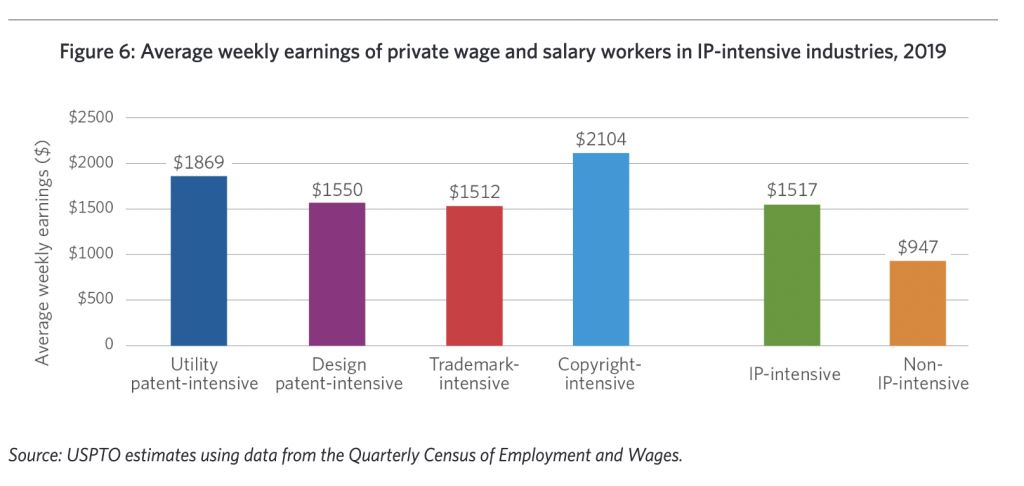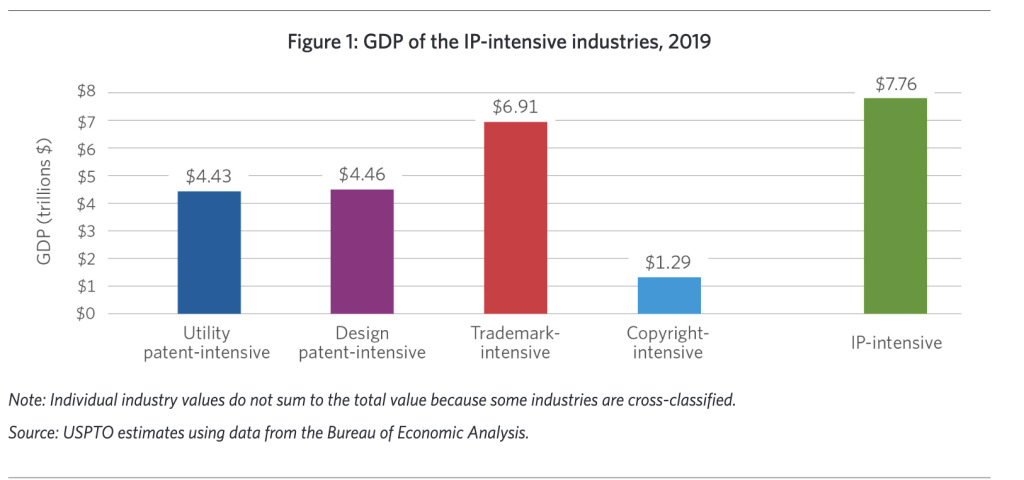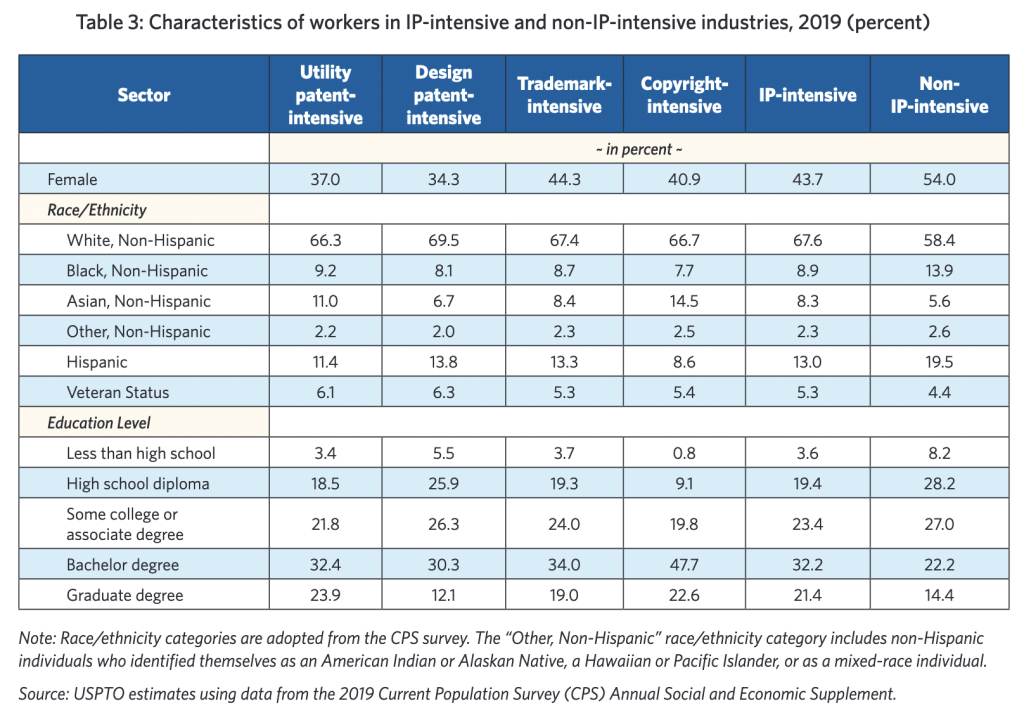“In 2019, the average weekly earnings of $1,517 for workers across all IP-intensive industries was 60% higher than weekly earnings for workers in other industries.”
The U.S. Patent and Trademark Office (USPTO) today released its third in a series of reports quantifying the contributions of IP-intensive industries to the U.S. economy. The report found that, in 2019, IP accounted for 41% of domestic economic activity and that IP-intensive industries accounted for 63 million jobs, or 44% of all U.S. employment. Direct employment accounted for 47.2 million jobs in 2019, or 33% of total U.S. employment. Indirect employment, which includes jobs created in other industries that depend at least partially on final sales in IP-intensive industries, accounted for an additional 11% of U.S. employment.
In 2019, the 127 IP-intensive industries covered by the report accounted for $7.8 trillion of the United States’ total 21.43 trillion GDP. Trademark-intensive industries accounted for nearly $7.0 trillion, while the utility patent–intensive and design patent–intensive industries each accounted for nearly $4.5 trillion. Copyright-intensive industries totaled just under $1.3 trillion. The report notes that some industries are cross-classified, so the individual totals add up to more than the total of $7.8 trillion.
Methodology
The report considered the amount of use across domestic industries of utility patents, design patents, trademarks and copyrights. As an update to the 2016 report, the USPTO matched the vast majority of utility patents, design patents, and trademark registrations granted to U.S.- based entities to the National Establishment Time Series (NETS) database, a private sector source of business data that, according to the USPTO report, “includes almost all U.S. business establishments, representing both public and private companies, as well as information on the primary industry for each establishment, among other measures.”
“By linking the individual IP rights with these company-level data, we now have a direct match of IP rights to both public and private companies,” said the report.
For copyright, the report referenced the Guide on Surveying the Economic Contribution of the Copyright-Based Industries from the World Intellectual Property Organization (WIPO). But the USPTO used a narrower definition of “copyright-intensive industries” than the WIPO report, defining them “as those primarily responsible for the creation or production of copyrighted materials,” thus excluding industries like book and music stores, which only distribute copyrighted material.
More Money
As previous reports have found, the data showed that workers in IP-intensive industries are more likely to earn higher wages (with the highest earnings in copyright, followed by patent, design patent and then trademark. In 2019, the average weekly earnings of $1,517 for workers across all IP-intensive industries was 60% higher than weekly earnings for workers in other industries. Workers in non-IP-intensive industries earned an average of $947 per week in 2019. Utility patent-intensive industries saw an average of $1,869 per week.
 The report also showed that workers in these industries are likelier to work in larger companies (500 employees or more); participate in employer-sponsored health insurance; participate in employer-sponsored retirement plans; have a bachelor’s or graduate degree; and be veterans.
The report also showed that workers in these industries are likelier to work in larger companies (500 employees or more); participate in employer-sponsored health insurance; participate in employer-sponsored retirement plans; have a bachelor’s or graduate degree; and be veterans.
The Gap Persists
The latest report also adds information on demographic data in IP-intensive sectors, drawing on annual employee survey data. Unsurprisingly, the report found that women and minorities were underrepresented in IP-intensive industries, with the exception of Asian minorities. Women comprised 43.7% of the workforce in IP-intensive industries, versus 54% in non-IP-intensive industries. Blacks and Hispanics respectively comprised 8.9% and 13% of the workforce in IP-intensive industries, versus 13.9% and 19.5% in non-IP-intensive industries.
The gap in women workers in these industries was most obvious in the design patent and utility patent–intensive industries. The report possibly attributed this to the fact that many workers in those industries are employed in manufacturing.
The first version of the report was published in 2012 by the Department of Commerce and was titled, “Intellectual Property and the U.S. Economy: Industries in Focus”. In 2016, the USPTO updated that report with the aptly named, “Intellectual Property and the U.S. Economy: 2016 Update.

![[IPWatchdog Logo]](https://ipwatchdog.com/wp-content/themes/IPWatchdog%20-%202023/assets/images/temp/logo-small@2x.png)



![[Advertisement]](https://ipwatchdog.com/wp-content/uploads/2024/04/Patent-Litigation-Masters-2024-sidebar-early-bird-ends-Apr-21-last-chance-700x500-1.jpg)

![[Advertisement]](https://ipwatchdog.com/wp-content/uploads/2021/12/WEBINAR-336-x-280-px.png)
![[Advertisement]](https://ipwatchdog.com/wp-content/uploads/2021/12/2021-Patent-Practice-on-Demand-recorded-Feb-2021-336-x-280.jpg)
![[Advertisement]](https://ipwatchdog.com/wp-content/uploads/2021/12/Ad-4-The-Invent-Patent-System™.png)







Join the Discussion
4 comments so far.
Anon
March 20, 2022 10:48 amI cannot disagree more that “Declining to pay USPTO and attorneys for a fraudulent patent grant is a necessary next step.”
As I have noted to you, THIS is what the Efficient Infringers want.
Josh Malone
March 19, 2022 07:39 pmAnon, I’m working every day on restoring the patent system. A lot of people think what we have is functional. It’s not. If naive inventors continue participating while falling for the scam, only to find out ten or fifteen years later, then there is no case for reform. Declining to pay USPTO and attorneys for a fraudulent patent grant is a necessary next step. But if we are willing to pay good money for these fake patents, then that is what they will continue to grant.
Anon
March 18, 2022 03:21 pmMr. Malone,
May I suggest that you put your emotions to the side and realize that any such (past and recurring) rants sounding in “Boycott” is exactly what your enemies want.
Do not become a pawn of your enemies.
Josh Malone
March 17, 2022 08:13 pmBut IP doesn’t mean what it used to in the U.S. This is just routine monopolies and mercantalism. Large corporations purchasing “public franchises” from the government to weaponize against small competitors with better ideas. IP-intensive used to mean disruptive and ever-increasing innovation. Not any more.
This is a self-serving report to propagate the USPTO cartel enriching large corporations, lawyers, and bureaucrats — and crush old-fashioned inventors.